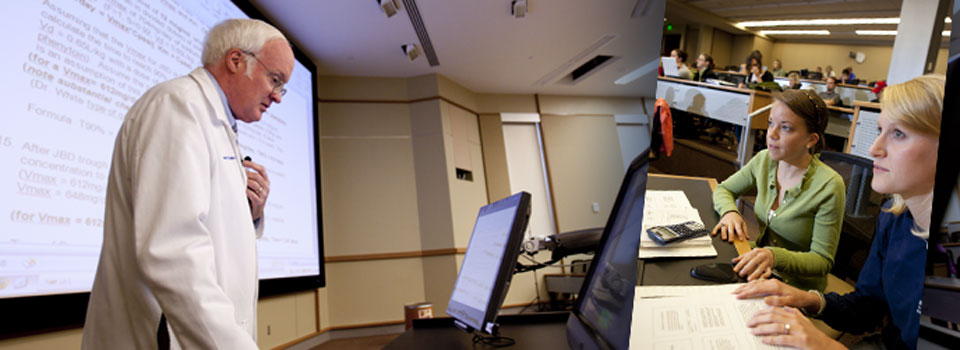A student picks up her pen, looks at the teacher, waits for a minute and presses a button on her table.
A camera trains toward her seat and the microphone at her station buzzes to life. “I have a question,” she says to the teacher, whose image is on the theater-sized screen at the front of the classroom. Welcome to higher education version 2.0.
This is a regular scene at the College of Pharmacy, where distance learning is a part of life. The students, who have long kept track of their social lives on Web sites like Facebook and Twitter, are increasingly using cutting-edge advances to bolster their academic pursuits as well. Welcome to higher education version 2.0.
“We built this building with this technology in mind,” said Sarah Jones, a program coordinator in the College of Pharmacy. “We have six classrooms equipped with cameras and microphones that are capable of videoconferencing to our remote sites, and we use them on a weekly if not daily basis.”
In a sense, the College of Pharmacy is a microcosm of the challenges and opportunities that technological advances provide for modern universities.
The culture itself is undergoing many changes.
The use of technology and social media in particular is changing the landscape and culture as a whole, and that’s seeping into the classroom,” said Nelson Hilton, director of UGA’s Center for Teaching and Learning. “It brings up a whole new question, not only where is the classroom, but what is the classroom?”
Face-to-face instruction, long the sole practice of teaching, is no longer always necessary. According to the CTL’s David Noah, learning can take place even in virtual communities. One such space, a program called Second Life, is an online 3-D world built and operated by more than six million users worldwide. CTL owns a virtual “island” in the program where students can meet for class, listen to lectures and interact through digital human representations called avatars.
“The sense of engagement you get in a virtual world is very real. You really do become your avatar,” Noah said.
Avatars can also visit the virtual home of the Georgia Museum of Art, which currently is closed for renovations. Its space in Second Life is a close replica of its real-life counterpart, complete with high-resolution images of the artwork housed in its galleries.
“It’s very real. People will walk in, stare at a painting and analyze it just like they do in real life,” said Jenny Williams, public relations coordinator at the museum. “I feel that art appreciators in Second Life act very similarly to how they act in the museum.”
As lines between the “real” world and the “virtual” world become even more blurred, it’s important that students and faculty understand not only how to operate within both worlds but also how to enhance them, said Casey O’Donnell, who oversees the UGA Video Game Lab in the Grady College of Journalism and Mass Communication’s New Media Institute.


